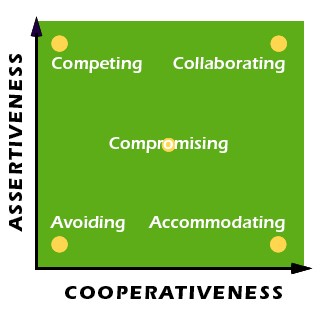 by Larry Gaughan
by Larry Gaughan
Even though two spouses in mediation fight at a distressing level of volume and intensity, it still may be possible for them to reach a settlement. It is important to recognize this fact. Consider the cases of two couples who met with a divorce mediator at around the same time some years ago (these are actual cases). Let’s call them Mr. & Ms. Nasty and Mr. & Ms. Nice.
 The Nasty’s were in their middle 40’s and their negotiations were quite obnoxious – insults, put-downs, threats and accusations, all in loud voices. The Nice’s were in their late 50’s and were ever-so-polite in talking to each other. However, the mediator noticed that after each frustrating and unpleasant meeting with the Nasty’s, the bottom line of their settlement grew ever closer. With the Nice’s, nothing ever seemed to budge. The way the Nasty’s negotiated was the way they got business done in their marriage, and it actually worked (to a point). But the Nice’s stayed frozen in a family system in which politeness was required, but where their family problems often never seemed to get resolved.
The Nasty’s were in their middle 40’s and their negotiations were quite obnoxious – insults, put-downs, threats and accusations, all in loud voices. The Nice’s were in their late 50’s and were ever-so-polite in talking to each other. However, the mediator noticed that after each frustrating and unpleasant meeting with the Nasty’s, the bottom line of their settlement grew ever closer. With the Nice’s, nothing ever seemed to budge. The way the Nasty’s negotiated was the way they got business done in their marriage, and it actually worked (to a point). But the Nice’s stayed frozen in a family system in which politeness was required, but where their family problems often never seemed to get resolved.
After the Nasty’s signed a quite fair and balanced agreement, Mr. Nasty walked over and gently put his hand on Ms. Nasty’s shoulder and asked her to join him for lunch. When the Nice’s realized that they weren’t going to get any agreement, they stalked silently and separately out of the conference room.
 The Nice’s might have reached an agreement if the mediator had diagnosed them as being the equivalent to a high conflict couple and moved to a structure of separate meetings, with carefully framed discussions of alternative options. This is the same approach that Bill Eddy recommends for the more obvious high conflict couples.
The Nice’s might have reached an agreement if the mediator had diagnosed them as being the equivalent to a high conflict couple and moved to a structure of separate meetings, with carefully framed discussions of alternative options. This is the same approach that Bill Eddy recommends for the more obvious high conflict couples.
Let’s look at how the parties in these two cases fit into two conflict resolution models. Both models appear below. The first was developed by Professor David H. Olson of the University of Minnesota, and the second is the Thomas-Kilmann model, which has also been made into a well-known test.
In the case of the Nasty’s, both parties were competitors, and they were somewhat emotionally enmeshed. But, they had learned that eventual compromising was necessary to get decisions made. The Nice’s, on the other hand, managed the emotions of the marriage by avoiding conflict, but the rigidity in both of them meant that they were unable to compromise. In the attached Olson model, they were inflexibly disconnected. Even their politeness with each other was just a way to live with the fact that their marriage had no viable way to adjust to many of the changes that every marriage faces. It came to a head when the separation forced them to confront the need for a settlement. As the Thomas-Kilmann model demonstrates, avoidance is the worst way to deal with conflict. The Nasty’s were overly connected, but sufficiently flexible to be able to compromise. But they still got divorced.
Here is the Couple and Family Map developed by David H. Olson:

This model may be compared with the well-known Thomas-Kilmann model of the ways in which different people approach conflict:

The T-K model ends up with the individual styles of negotiation. It can be made into a sort of family systems model if you place each party on the chart. The position of each party in the model then becomes a starting point for charting their interactions. Their styles of negotiating represent the outcome of their negotiating relationship, with collaboration as the ideal goal.
The Olson model starts instead with the family system ideas of flexibility and emotional closeness or distance. The most productive place for effective problem-solving is the area between emotional enmeshment and emotional distance when that coincides with the area between excessive and insufficient flexibility.
Neither of these models offers a comprehensive explanation of how and why the best (and the worst) negotiations between husband and wife take place. The models supplement each other. In the T-K model, the worst potential for successful negotiation is mutual avoidance, and the best is optimal assertiveness (self) and cooperation (other), leading to collaboration. In the Olson model, the worst potential is when both parties are in any of the four corners of the model, and the best is when both parties are in the balanced center.
The final key to understanding the Nasty’s is their ultimate flexibility, while with the Nice’s, it is their rigid inflexibility, because these tell us more about their case than the Nasty’s emotional enmeshment or the Nice’s emotional distance.
For further information on the Thomas-Kilmann Conflict Mode Instrument, see Kilman Diagnostics. David H. Olson’s couple & family map is explained here.
_________
Larry Gaughan was admitted to practice law in Montana in 1957, and in Virginia in 1967. He was a tenured full professor at Washington & Lee and George Mason Law Schools. As an attorney, he is rated by Martindale-Hubbell, the national rating service for lawyers, as “AV® Preeminent™.” Larry has been a family mediator since 1980 and is a Founding Member of APFM. He is a member of APFM’s Professional Mediation Board of Standards.
